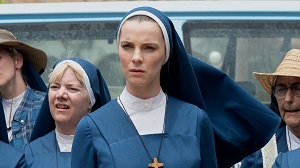
— 1 —
Get your travel bug on: The family of Bearing Blog is in Europe at the moment, and the mom is doing a fabulous job blogging it, and just as fabulous a job of feeding her large family while on vacation. I always have such big plans and high hopes for cooking interesting things with new, fascinating ingredients when I’m in a new place, but somehow…takeout always beckons. (Although in my own defense…the takeout can be pretty good….)
— 2 —
Most entertaining part of my Thursday was, as I was waiting for piano to be over, standing in a hallway of a college classroom building and watching as successive groups of students approach a door and learn that their scheduled exam had been moved to next week.
Much leaping, skipping, and, since this is a Baptist school, praising of Jesus!
I remember a time when the notion of applying to Duke Divinity School would have been akin to applying to Harvard.
Here’s the subject header of an advertising email I received yesterday:
Duke Divinity School: Apply Using Discount Code DukeCT
???
Worth a read: “The Borromeo Option”
Despite his importance, Charles Borromeo is little known and appreciated within the English-speaking world, primarily because few of his works have been translated. This lacuna has now been filled with the publication of Charles Borromeo: Selected Orations, Homilies and Writings. J.R. Cihak and A. Santogrossi have furnished us with a superb edition and translation of some of Charles’s most significant texts.
Cihak’s introduction provides a short, but splendid, biography of Charles, and a guide to the historical, ecclesial, and pastoral setting for his writings. There follow four sections, which highlight various aspects of Charles’s work.
The first presents orations that Charles gave at his provincial councils. Here he articulates the need for reform and the nature of the reform. Charles notes that the true bishop “is frequently at prayer and in contemplation of heavenly things.” He is “regularly present in the episcopal residence, and likewise totally dedicated and given over to his episcopal duties.” He is “a true father and pastor of the poor, widows and orphans, a patron of the holy places and assiduous in promoting holy observances.”
There is, however, “another bishop.” He “is remiss or negligent in all of these things, or what is worse, does the opposite.” For Charles, his fellow bishops and priests are to be men of the Gospel who love the Church and the people they serve. Above all, they are to be holy shepherds after the manner their supreme Shepherd – Jesus Himself.
Thus, Charles displays both his love for his fellow bishops and priests as well as the need to challenge them if the Church and people of God are to grow in holiness.
From the UK Catholic Herald, “Stop Teaching Our Children Lazy Anti-Catholic Myths:”
Saying that medieval peasants were “extremely superstitious” is one thing; it’s easy to sneer at abstractions. But if you read medieval records of sick people visiting holy shrines, those involved emerge not as stereotypes but as real human beings: men and women from all classes of society, seeking aid in the extremes of pain and suffering, with stories of self-sacrifice and deep personal faith. From a modern viewpoint, some of their beliefs might seem alien, but their fears and hopes are not. These people and their beliefs deserve respect, and at least an attempt at understanding. All this was a sanctification of the everyday, a vision of a world charged with power and meaning – and for medieval scholars, none of it was incompatible with science or learning.
No one would pretend that the medieval period was perfect or that the medieval Church did not have some serious flaws. What’s needed today is a more balanced view, appreciating that the Middle Ages was as complex as any other period in history, and avoiding judgmental, emotive language like “stagnation” and “superstition”. There’s no excuse for it any more.
It has never been easier to access information about the medieval past, especially when a few minutes on Google will lead you to accessible websites written by experts on medieval science and religion, not only debunking myths but also providing more accurate information.
It’s past time for educators and journalists to move beyond the lazy stereotypes about the Middle Ages. The truth is far more interesting.
— 6 —
Homeschooling? Going well, with a couple of interruptions this week. Schools were cancelled here on Monday, and my older son had a delayed opening on Tuesday. The public schools were also closed on Tuesday (it had been a proactive decision handed down Sunday night when no one knew if Irma would impact us – it didn’t much), so the science center homeschool class was cancelled, and then the homeschooler had two teeth extracted on Wednesday….so…scattered.
But we did discover this set of fun videos – they are pitched a little younger, but the fact that they’re British evens that out so that they’re quite entertaining to watch for any age:
Book talk!
As I noted earlier in the week, my old booklet on St. Nicholas has been brought back into print. Get ready for Christmas – especially if you’re a parish or school coordinator of such things!
Celebrate the feast of Our Lady of Sorrows with a (still) free download of my book, Mary and the Christian Life.
Get a cheap e-book on Mary Magdalene here – Mary Magdalene: Truth, Legends and Lies.
As I mentioned last week, The Loyola Kids Book of Bible Stories is available.It looks like it’s finally shipping from Amazon in a timely manner…
But you can also certainly order it from Loyola, request it from your local bookstore, or, if you like, from me – I have limited quantities available. Go here for that.
For more Quick Takes, visit This Ain’t the Lyceum!
























































